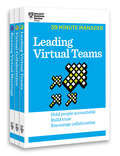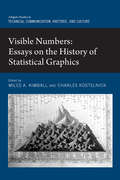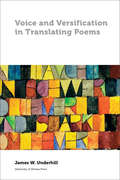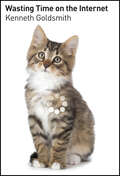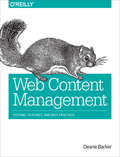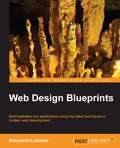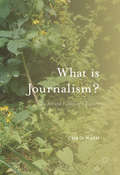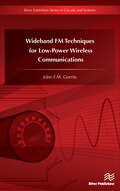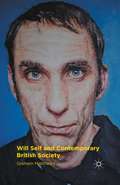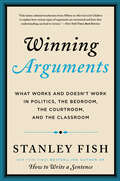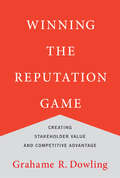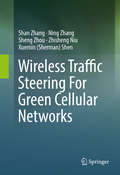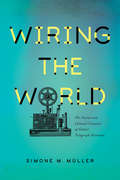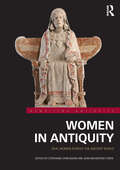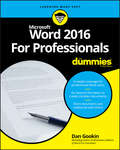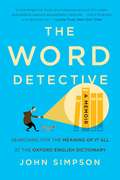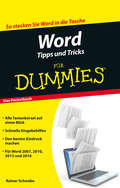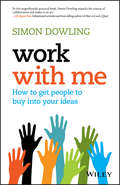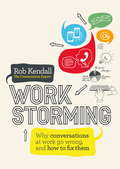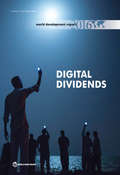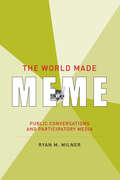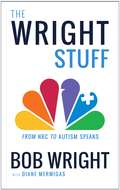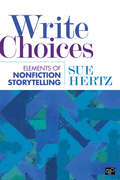- Table View
- List View
The Virtual Manager Collection (3 Books) (HBR 20-Minute Manager Series)
by Harvard Business ReviewToday we have greater control over where and when we work. As our businesses spread across the world and technology makes it easy to do our jobs from anywhere there's Wi-Fi, more of us have the option to go remote. But that doesn't mean we're good at it. Whether you're calling in from a home office every day or one of your team members occasionally logs in from the quiet car on a train, distance can make collaboration more difficult. Remote work gives teams flexibility and options, but when you're not face-to-face with colleagues, it's difficult to set and manage expectations, deal with inevitable tech glitches, keep your people (and yourself) motivated and engaged, and infuse warmth and personality into the blunt communication tools you're using.The Virtual Manager Collection gives you the solutions you need to be productive, whether you're managing a team, a project, or just your own work. This specially priced three-volume set includes Virtual Collaboration, Running Virtual Meetings, and Leading Virtual Teams.Tips and strategies cover: getting your technology up and running-and keeping it there building and maintaining relationships from afar communicating well through a variety of media running productive virtual meetings setting and managing expectations for your work leading geographically dispersed teamsThis set has the practical advice, insights, and tools you need to work well, no matter where you are.Don't have much time? Get up to speed fast on the most essential business skills with HBR's 20-Minute Manager series. Whether you need a crash course or a brief refresher, each book in the series is a concise, practical primer that will help you brush up on a key management topic. Advice you can quickly read and apply, for ambitious professionals and aspiring executives-from the most trusted source in business. Also available as an ebook.
Visible Numbers: Essays on the History of Statistical Graphics
by Charles KostelnickBringing together scholars from around the world, this collection examines many of the historical developments in making data visible through charts, graphs, thematic maps, and now interactive displays. Today, we are used to seeing data portrayed in a dizzying array of graphic forms. Virtually any quantified knowledge, from social and physical science to engineering and medicine, as well as business, government, or personal activity, has been visualized. Yet the methods of making data visible are relatively new innovations, most stemming from eighteenth- and nineteenth-century innovations that arose as a logical response to a growing desire to quantify everything-from science, economics, and industry to population, health, and crime. Innovators such as Playfair, Alexander von Humboldt, Heinrich Berghaus, John Snow, Florence Nightingale, Francis Galton, and Charles Minard began to develop graphical methods to make data and their relations more visible. In the twentieth century, data design became both increasingly specialized within new and existing disciplines-science, engineering, social science, and medicine-and at the same time became further democratized, with new forms that make statistical, business, and government data more accessible to the public. At the close of the twentieth century and the beginning of the twenty-first, an explosion in interactive digital data design has exponentially increased our access to data. The contributors analyze this fascinating history through a variety of critical approaches, including visual rhetoric, visual culture, genre theory, and fully contextualized historical scholarship.
Voice and Versification in Translating Poems (Perspectives on Translation)
by James W. UnderhillGreat poets like Shelley and Goethe have made the claim that translating poems is impossible. And yet, poems are translated; not only that, but the metrical systems of English, French, Italian, German, Russian and Czech have been shaped by the translation of poems. Our poetic traditions are inspired by translations of Homer, Dante, Goethe and Baudelaire. How can we explain this paradox? James W. Underhill responds by offering an informed account of meter, rhythm, rhyme, and versification. But more than that, the author stresses that what is important in the poem—and what must be preserved in the translated poem—is the voice that emerges in the versification. Underhill’s book draws on the author’s translation experience from French, Czech and German. His comparative analysis of the versifications of French and English have enabled him to revise the key terms involved in translating the poetic voice and transposing the poem’s versification. The theories of versification from the Prague School of Linguistics, the French and Swiss schools of versification, and recent scholarship in metrics and rhythm in the UK and in the USA have been integrated into this synthetic but rigorously coherent approach to translating poems. The extensive glossary at the end of the book will prove useful for both students and teachers alike. And the detailed case studies on translating poems by Baudelaire and Emily Dickinson allow the author to categorize and appraise the various poetic and aesthetic strategies and theories that are brought to bear in translating Baudelaire into English, and Dickinson into French.
Wasting Time on the Internet
by Kenneth GoldsmithUsing clear, readable prose, conceptual artist and poet Kenneth Goldsmith’s manifesto shows how our time on the internet is not really wasted but is quite productive and creative as he puts the experience in its proper theoretical and philosophical context.Kenneth Goldsmith wants you to rethink the internet. Many people feel guilty after spending hours watching cat videos or clicking link after link after link. But Goldsmith sees that “wasted” time differently. Unlike old media, the internet demands active engagement—and it’s actually making us more social, more creative, even more productive.When Goldsmith, a renowned conceptual artist and poet, introduced a class at the University of Pennsylvania called “Wasting Time on the Internet”, he nearly broke the internet. The New Yorker, the Atlantic, the Washington Post, Slate, Vice, Time, CNN, the Telegraph, and many more, ran articles expressing their shock, dismay, and, ultimately, their curiosity. Goldsmith’s ideas struck a nerve, because they are brilliantly subversive—and endlessly shareable.In Wasting Time on the Internet, Goldsmith expands upon his provocative insights, contending that our digital lives are remaking human experience. When we’re “wasting time,” we’re actually creating a culture of collaboration. We’re reading and writing more—and quite differently. And we’re turning concepts of authority and authenticity upside-down. The internet puts us in a state between deep focus and subconscious flow, a state that Goldsmith argues is ideal for creativity. Where that creativity takes us will be one of the stories of the twenty-first century.Wide-ranging, counterintuitive, engrossing, unpredictable—like the internet itself—Wasting Time on the Internet is the manifesto you didn’t know you needed.
Web Content Management: Systems, Features, and Best Practices
by Deane BarkerLooking to select a web content management system (CMS), but confused about the promises, terminology, and buzzwords? Do you want to understand content management without having to dive into the underlying programming? This book provides a clear, unbiased overview of the entire CMS ecosystem--from platforms to implementations--in a language- and platform-agnostic manner for project managers, executives, and new developers alike.Author Deane Barker, a CMS consultant with almost two decades of experience, helps you explore many different systems, technologies, and platforms. By the end of the book, you'll have the knowledge necessary to make decisions about features, architectures, and implementation methods to ensure that your project solves the right problems.Learn what content is, how to compare different systems, and what the roles of a CMS team areUnderstand how a modern CMS models and aggregates content, coordinates workflow, and manages assetsExplore the scope and structure of a CMS implementation projectLearn the process and best practices for successfully running your CMS implementationExamine the practice of migrating web content, and learn how to work with an external CMS integrator
Web Design Blueprints
by Benjamin LagroneBuild websites and applications using the latest techniques in modern web development About This Book * Create amazing modern day applications that run seamlessly across multiple platforms * Implement multiple methodologies by creating different apps with dynamic features * This unique project-based guide will help you build your own websites efficiently Who This Book Is For This book is a must-have for web developers who want to stay on top of the latest trends in web app and site development. If you are a web developer who is already familiar with HTML, CSS, and functional JavaScript, and you want to learn the latest trends in web development, this is the book for you. What You Will Learn * Find out how to create responsive websites * Create websites using the principals of Flat design * Create deep-dive sites using parallax scrolling * Discover how to use Ajax in single-page applications * Create responsive navigation with CSS and JavaScript * Create responsive padding with the box model property In Detail The book delivers simple instructions on how to design and build modern Web using the latest trends in web development. You will learn how to design responsive websites, created with modern Flat User Interface design patterns, build deep-scrolling websites with parallax 3D effects, and roll-your-own single-page applications. Finally, you'll work through an awesome chapter that combines them all. Each chapter features actual lines of code that you can apply right away. Style and Approach Using real-world examples, Web Design Blueprints presents practical how-to projects for site enhancements, with a light-hearted, easy-to-understand tone. This book has individual projects that cumulate until you finally build a super-project at the end, using all the skills learned
What is Journalism?
by Chris NashThis book argues that journalism should treat itself as an academic discipline on a par with history, geography and sociology, and as an art form in its own right. Time, space, social relations and imagination are intrinsic to journalism. Chris Nash takes the major flaws attributed to journalism by its critics--a crude empiricism driven by an un-reflexive 'news sense'; a narrow focus on a de-contextualised, transient present; and a too intimate familiarity with powerful sources--and treats them as methodological challenges. Drawing on the conceptual frameworks of Pierre Bourdieu, David Harvey, Henri Lefebvre, Michel-Rolph Trouillot and Gaye Tuchman, he explores the ways in which rigorous journalism practice can be theorised to meet these challenges. The argument proceeds through detailed case studies of work by two leading iconoclasts--the artist Hans Haacke and the 20th century journalist I. F. Stone. This deeply provocative and original study concludes that the academic understanding of journalism is fifty years behind its practice, and that it is long past time for scholars and practitioners to think about journalism as a disciplinary research practice. Drawing on an award-winning professional career and over three decades teaching journalism practice and theory, Chris Nash makes these ideas accessible to a broad readership among scholars, graduate students and thoughtful journalists looking for ways to expand the intellectual range of their work.
Why Leadership Training Fails--and What to Do About It
by Michael Beer Magnus Finnstrom Derek Schrader"The Problem Companies are dumping billions of dollars into training and development programs—but their investments aren’t paying off. The Reason Six common managerial and organizational barriers prevent people from applying what they’ve learned, no matter how smart and motivated they are. The Solution To create a favorable context for learning and growth, senior executives must first attend to organizational design—both at the very top and unit by unit."
Wideband FM Techniques for Low-Power Wireless Communications
by John F.M. GerritsUltra Wideband (UWB) communications are poised to enable short-range applications, such as remote health monitoring (e-health) and home or office automation. Sensor networks are also suitable candidates for UWB since the low radiated power of the UWB transmitter enables low DC power consumption, yielding long battery life and the possibility to use energy scavenging. Size and cost constraints require a low-complexity approach that allows multiple users to share the same RF bandwidth, and offers robustness to interference, frequency-selective multipath and antenna mismatch. Wideband FM Techniques for Low-Power Wireless Communications presents research and applications that have taken place in UWB Communications over the past years. This book is being published posthumously in agreement with the authors’ former colleagues from both the Swiss Center for Electronics and Microtechnology (CSEM) and Delft University of Technology in The Netherlands.
Will Self and Contemporary British Society
by G. MatthewsThis stimulating and comprehensive study of Will Self's work spans his entire career and offers insightful readings of all his fictional and non-fictional work up to and including his Booker prize nominated novel Umbrella.
Winning Arguments: What Works and Doesn't Work in Politics, the Bedroom, the Courtroom, and the Classroom
by Stanley Fish“Fish mines cultural touchstones from Milton to ‘Married with Children’ to explain how various types of arguments are structured and how that understanding can lead to victory” — New York Times Book ReviewA lively and accessible guide to understanding rhetoric by the world class English and Law professor and bestselling author of How to Write a Sentence.Filled with the wit and observational prowess that shaped Stanley Fish’s acclaimed bestseller How to Write a Sentence, Winning Arguments guides readers through the “greatest hits” of rhetoric. In this clever and engaging guide, Fish offers insight and outlines the crucial keys you need to win any debate, anywhere, anytime—drawn from landmark legal cases, politics, his own career, and even popular film and television. A celebration of clashing minds and viewpoints, Winning Arguments is sure to become a classic.
Winning the Reputation Game: Creating Stakeholder Value and Competitive Advantage
by Grahame R. DowlingCore strategies for creating a corporate reputation that will provide a competitive advantage in the marketplace: a back-to-basics approach. What does a company have to do to be admired and respected? Why does Apple have a better reputation than, say, Samsung? In Winning the Reputation Game, Grahame Dowling explains. Companies' reputations do not derive from consultant-recommended campaigns to showcase efforts at corporate transparency, environmental sustainability, or social responsibility. Companies are admired and respected because they are “simply better” than their competitors. Companies that focus on providing outstanding goods and services are rewarded with a strong reputation that helps them gain competitive advantage. Dowling, who has studied corporate reputation–building for thirty years, describes two core strategies for creating a corporate reputation that will provide a competitive advantage: to be known for being Best at Something or for being Best for Somebody. Apple, for example, is best at personal technology products that enhance people's lifestyles. IKEA is best for people who want well-designed furniture at affordable prices. Dowling covers such topics as the commercial value of a strong reputations—including good employees, repeat customers, and strong share price; how corporate reputations are formed; the power of “being simply better”; the effectiveness of corporate storytelling (for good or ill; Kenneth Lay of Enron was a master storyteller); and keeping out of trouble. Drawing on many real-world examples, Dowling shows how companies that are perceived to be better than their competitors build strong reputations that reflect past success and promise more of the same. Companies that artificially engineer a reputation with irrelevant activities but have stopped providing the best products and services available often wind up with mediocre—or worse—reputations.
Wireless Traffic Steering For Green Cellular Networks
by Shan Zhang Ning Zhang Sheng Zhou Zhisheng Niu Xuemin Sherman ShenThis book introduces wireless traffic steering as a paradigm to realize green communication in multi-tier heterogeneous cellular networks. By matching network resources and dynamic mobile traffic demand, traffic steering helps to reduce on-grid power consumption with on-demand services provided. This book reviews existing solutions from the perspectives of energy consumption reduction and renewable energy harvesting. Specifically, it explains how traffic steering can improve energy efficiency through intelligent traffic-resource matching. Several promising traffic steering approaches for dynamic network planning and renewable energy demand-supply balancing are discussed. This book presents an energy-aware traffic steering method for networks with energy harvesting, which optimizes the traffic allocated to each cell based on the renewable energy status. Renewable energy demand-supply balancing is a key factor in energy dynamics, aimed at enhancing renewable energy sustainability to reduce on-grid energy consumption. Dynamic network planning adjusts cell density with traffic variations to provide on-demand service, which reduces network power consumption with quality of service provisioning during off-peak hours. With intra- or inter-tier traffic steering, cell density is dynamically optimized with regards to the instant traffic load for conventional homogeneous and multi-tier heterogeneous cellular networks, respectively. This book is beneficial for researchers and graduate students interested in traffic management and future wireless networking.
Wiring the World: The Social and Cultural Creation of Global Telegraph Networks (Columbia Studies in International and Global History)
by Simone MüllerThe successful laying of a transatlantic cable in 1866 remade world communications. A message could travel across the ocean in minutes, shrinking the space between continents, cultures, and nations. An eclectic group of engineers, entrepreneurs, politicians, and media visionaries then developed this technology into a telecommunications system that spread a particular vision of civilization—but not everyone wanted to wire the world the same way. Wiring the World is a cultural and social history that explores how the large Anglo-American cable companies won out over alternative visions. Bitter rivalries emerged over telegram prices, visions for world peace, scientific innovation, and the role of the nation-state. Such struggles determined the growth of cable technology, which in turn influenced world history. Filled with fascinating characters and new insights into pivotal events, Wiring the World traces globalization's diverse paths and close ties to business and politics.
Women in Antiquity: Real Women across the Ancient World (Rewriting Antiquity)
by Jean Macintosh Turfa Stephanie Lynn BudinThis volume gathers brand new essays from some of the most respected scholars of ancient history, archaeology, and physical anthropology to create an engaging overview of the lives of women in antiquity. The book is divided into ten sections, nine focusing on a particular area, and also includes almost 200 images, maps, and charts. The sections cover Mesopotamia, Egypt, Anatolia, Cyprus, the Levant, the Aegean, Italy, and Western Europe, and include many lesser-known cultures such as the Celts, Iberia, Carthage, the Black Sea region, and Scandinavia. Women's experiences are explored, from ordinary daily life to religious ritual and practice, to motherhood, childbirth, sex, and building a career. Forensic evidence is also treated for the actual bodies of ancient women. Women in Antiquity is edited by two experts in the field, and is an invaluable resource to students of the ancient world, gender studies, and women's roles throughout history.
Word 2016 For Professionals For Dummies
by Dan GookinWhat the book covers: In this leading book about the world's number-one word processing software, Dan Gookin talks about using Microsoft Word in friendly, human--and often irreverent--terms. Based on his own experience, he focuses on the needs of the Word Power User by offering deep coverage of the topics professionals want more information about so they can be more productive and efficient.
The Word Detective: Searching for the Meaning of It All at the Oxford English Dictionary
by John Simpson"A charmingly full, frank, and humorous account of a career dedicated to rigorous lexicographic rectitude. . . . He is an absolute hero."-Lynne Truss, New York TimesCan you drink a glass of balderdash? And what do you call the part of a dog's back it can't scratch? The answers to these questions can be found in the Oxford English Dictionary. There is no better guide to the dictionary's many wonderments than its former chief editor, John Simpson. In The Word Detective, an intensely personal memoir and a joyful celebration of English, he weaves a story of how words come into being, how culture shapes language, and how technology transforms words. A brilliant and deeply humane expedition through the world of words, The Word Detective will delight and inspire any lover of language.
Word Magic: Tested Answers to 100 Everyday Situations
by Elmer WheelerAbout ten years ago, a newspaper man developed an idea for increasing sales through a more effective use of words. Now, Elmer Wheeler, its originator, has put into this new book the fundamental principles responsible for his success and has adapted them to help you meet those many personal situations confronting you at home, in the office, and in society.No matter who you are, no matter what your position in life is, you depend upon words for your success and happiness. The right words can win you a job, a wife, or a promotion. The wrong words can lose friends for you in social life, block your progress in business, or make you miss your big chance.Adopting a keen, homely, back-to-the-woods philosophy, Mr. Wheeler has taken an ordinarily serious subject and dramatized it so that anyone can put it to immediate and practical use.
Word Tipps und Tricks für Dummies (Für Dummies)
by Rainer W. SchwabeAuf ein gutes Word! Sie möchten endlich in Word Ihre Arbeitsabläufe effektiver gestalten? Dann ist das Taschenbuch mit dem Aha-Effekt genau das Richtige für Sie! Rainer Schwabe zeigt kurz und bündig, wie Sie Word nach Ihren Anforderungen und Wünschen gestalten und mit welchen geheimen Tricks alles noch viel schneller geht. Heben Sie sich aus der Word-Masse zum Beispiel mit richtigen Serienbriefen, schönem Layout und übersichtlichen Tabellen hervor. Machen Sie schnelle Eingaben, erstellen Sie eigene Tastenkürzel und Befehle. Schöpfen Sie aus dem Word-Vollem!
Work with Me: How to get people to buy into your ideas
by Simon DowlingLead from any level with the power of buy-in Work with Me shows you how to master the art of the 'buy-in.' You achieve better results when people go along with your ideas because they want to, not because they have to; the key is knowing how to build that kind of commitment This is the art of buy-in, and it's one of the most powerful skills you can have. When people are fully on board, they bring their full selves to the project. This drives their priorities, their performance, their innovation and ultimately, your outcome. Buy-in sits at the heart of creative and collaborative cultures; it drives highly adaptive and nimble teams. This book is a how-to guide for achieving buy-in, regardless of your leadership level. It's not about using power and authority, it's about building support and commitment to your ideas and initiatives. You can lead from any level, even laterally, and have a positive impact on the way things are done in your organisation. This book is your coach for speaking up, standing out and embracing the changes that fuel engaged workplaces and better business. Build engagement, agreement, commitment and ownership Overcome obstacles and drive stellar performance Deliver optimal outcomes through enthusiastic collaboration Boost creativity, passion, energy and focus In the shift from traditional industrial economies to a value-focused economy of ideas, organisations thrive on great ideas, but those ideas don't count unless they're actually implemented. Work with Me shows you how to get people on board so you can bring great ideas to life.
Workstorming
by Rob KendallWhatever your job you need to communicate with others, as even when your intentions are sound, the impact of a bad conversation can be highly destructive. If people in your work community form a negative opinion of you, they stop properly listening. Rob explains how and why your career success can depend so much on good communication at work. Each chapter is short and self-contained, focusing on a specific topic with clear steps for action and a key lesson. As in Blamestorming, there is a cast of characters placed in a variety of situations in which they experience conversations go wrong. Using five simple 'warning signs' to watch out for Rob explains how the characters could change the way they speak and listen in order to achieve a positive outcome.
World Development Report 2016
by World Bank GroupDigital technologies are spreading rapidly, but digital dividends--the broader benefits of faster growth, more jobs, and better services--are not. If more than 40 percent of adults in East Africa pay their utility bills using a mobile phone, why can't others around the world do the same? If 8 million entrepreneurs in China--one third of them women--can use an e-commerce platform to export goods to 120 countries, why can't entrepreneurs elsewhere achieve the same global reach? And if India can provide unique digital identification to 1 billion people in five years, and thereby reduce corruption by billions of dollars, why can't other countries replicate its success? Indeed, what's holding back countries from realizing the profound and transformational effects that digital technologies are supposed to deliver? Two main reasons. First, nearly 60 percent of the world's population are still offline and can't participate in the digital economy in any meaningful way. Second, and more important, the benefits of digital technologies can be offset by growing risks. Startups can disrupt incumbents, but not when vested interests and regulatory uncertainty obstruct competition and the entry of new firms. Employment opportunities may be greater, but not when the labor market is polarized. The internet can be a platform for universal empowerment, but not when it becomes a tool for state control and elite capture. The World Development Report 2016 shows that while the digital revolution has forged ahead, its "analog complements ?--the regulations that promote entry and competition, the skills that enable workers to access and then leverage the new economy, and the institutions that are accountable to citizens--have not kept pace. And when these analog complements to digital investments are absent, the development impact can be disappointing. What, then, should countries do? They should formulate digital development strategies that are much broader than current information and communication technology (ICT) strategies. They should create a policy and institutional environment for technology that fosters the greatest benefits. In short, they need to build a strong analog foundation to deliver digital dividends to everyone, everywhere.
The World Made Meme: Public Conversations and Participatory Media (The Information Society Series)
by Ryan M. MilnerHow memetic media—aggregate texts that are collectively created, circulated, and transformed—become a part of public conversations that shape broader cultural debates.Internet memes—digital snippets that can make a joke, make a point, or make a connection—are now a lingua franca of online life. They are collectively created, circulated, and transformed by countless users across vast networks. Most of us have seen the cat playing the piano, Kanye interrupting, Kanye interrupting the cat playing the piano. In The World Made Meme, Ryan Milner argues that memes, and the memetic process, are shaping public conversation. It's hard to imagine a major pop cultural or political moment that doesn't generate a constellation of memetic texts. Memetic media, Milner writes, offer participation by reappropriation, balancing the familiar and the foreign as new iterations intertwine with established ideas. New commentary is crafted by the mediated circulation and transformation of old ideas. Through memetic media, small strands weave together big conversations. Milner considers the formal and social dimensions of memetic media, and outlines five basic logics that structure them: multimodality, reappropriation, resonance, collectivism, and spread. He examines how memetic media both empower and exclude during public conversations, exploring the potential for public voice despite everyday antagonisms. Milner argues that memetic media enable the participation of many voices even in the midst of persistent inequality. This new kind of participatory conversation, he contends, complicates the traditional culture industries. When age-old gatekeepers intertwine with new ways of sharing information, the relationship between collective participation and individual expression becomes ambivalent. For better or worse—and Milner offers examples of both—memetic media have changed the nature of public conversations.
The Wright Stuff: From NBC to Autism Speaks
by Bob Wright Diane MermigasThe former CEO of NBC &“reflects on his years at the pinnacle of network television, and also on the Wrights&’ work as co-founders of Autism Speaks&” (Palm Beach Daily News). Named president and CEO of NBC at the age of 43, he faced a two-headed dragon: on one hand, distrust from the network people deeply skeptical of the &“suit&” from GE, their new corporate parent; and on the other, fiscal oversight demands from a cautious, conservative institution reluctant to invest heavily in a media business they didn&’t understand. For the next 20 years, he managed to navigate the fine line between the two and in the process completely reinvent—and save—the network. His name is Bob Wright. Under his leadership, a traditional network, struggling to survive a changing landscape, was transformed into a $45 billion cable and internet giant. What does someone like that do when he retires? If he&’s Bob Wright, he starts all over again. At almost the exact same time as Bob&’s NBC reign was winding down, his grandson Christian was diagnosed with autism, a condition then poorly understood. Baffled by a lack of medical knowledge and community support, Bob and his wife Suzanne founded Autism Speaks, which in short order became the leading advocacy and research funding organization for this mysterious condition that so devastates families. As the two story lines unfold in The Wright Stuff, readers will gradually see that both endeavors—revitalizing NBC and building Autism Speaks—reflect the same key management tenets that apply to any organization facing disruptive change. A portion of the proceeds from this book will be donated to advance autism research.
Write Choices: Elements of Nonfiction Storytelling
by Susan Sue HertzDeveloping nonfiction writers at any stage of their career Write Choices: Elements of Nonfiction Storytelling helps writers cultivate their nonfiction storytelling skills by exploring the universal decisions writers confront when crafting any kind of factual narrative. Rather than isolating various forms of narrative nonfiction into categories or genres, Sue Hertz focuses on examining the common choices all true storytellers encounter, whether they are writing memoir, literary journalism, personal essays, or travel essays. And since today’s writers are no longer confined to paper, Write Choices also includes digital storytelling options, and how writers can employ technology to enhance their narratives. Integrating not only her own insights and experience as a journalist, nonfiction book author, and writing instructor, but also those of other established nonfiction storytellers, both print and digital, Hertz aims to guide writers through key decisions to tell the best story possible. Blending how-to instruction with illuminating examples and commentaries drawn from original interviews with master storytellers, Write Choices is a valuable resource for all nonfiction writers, from essayists to memoirists to literary journalists, at any stage of their career.
